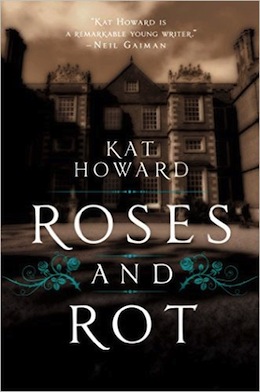When Imogen was a little girl, she told her sister Marin fairy tales. Once upon a time, she’d tell her, there was a way out—a way out of their house, out of their lives, and out of the oppressive clutches of their abusive mother—on the backs of fairies. As an adult, of course, Imogen knows that half her way out had been in the telling of the tales; and so she continues to tell them, as a writer still grappling with the terrors of her childhood. Reunited with her sister at an exclusive artists’ retreat, though, Imogen is forced to confront her past head-on. Fairy tales may be the solution yet again, but this time, it’s not Imogen alone that will shape the story, and her happy ending may be just out of grasp.
Kat Howard’s debut novel, Roses and Rot is as dark and engrossing as its title suggests, a contemporary fairy tale for artists, survivors, and anyone that has ever sought escape in a story. At Melete, mysterious and prestigious artists’ retreat, Imogen and Marin face a challenge that is familiar to many of us: creating a work of art that will prove to them that their struggles have been worth it. Despite the breathless beauty and small comforts at every corner of the sprawling, idyllic campus, Imogen struggles to live up to the expectations of Melete, feeling as though she’s watched at every moment by judging eyes. It is, as I said, a familiar scenario for the creative audience: imposter syndrome, fear, and pride war in Imogen and her cohort. The friendships they create, though, and the rekindled bond between Imogen and Marin, carry them through. Until, of course, they’re set against one another.
Imogen’s tale is filled with twists and turns, fantastic reveals and revelations that I’m loathe to spoil in a review. I will spoil this small thing though, since you might have guessed it already: this fairy tale does include fairies, and they are every bit as sinister and wonderful as their Grimm-dark predecessors. More vital, though, than even the fae themselves, is the atmospheric setting that they inhabit. Melete is as much the protagonist of this tale as Imogen. Its buildings, forests, and night markets are lush enough to make you yearn for them, and haunting enough to check your desires. Like the moors of Wuthering Heights or the cruel whimsy of Hogwarts’ Forbidden Forest, Roses and Rot’s setting is as striking and emotional as a burst of inspiration.
It’s fitting that the setting of the novel should so much embody its central theme of artistic creation and expression. Besides her gorgeous descriptions of Melete, Howard’s prose also lends itself well to dance, to art, and to music, all pursuits of Melete’s talented fellows. My only complaint, however, is with Imogen’s own writing—sprinkled throughout the novel, these excerpts are not nearly as compelling or as well-written as the novel itself. They do the vital job of setting tone and of giving us glimpses into Imogen’s head, but because the novel told me they were meant to be genius-level, best-seller material, I tended to be more disconnected from them than anything. I’d sooner nominate Howard for a Melete fellowship than I would her character.
Of course, there’s always a risk involved in writing so explicitly about genius (Howard doesn’t throw around the word, but I do think it’s implied) and creativity. Apart from Imogen’s ephemeral but insubstantial fairy tales, the novel thrives in its ambition. Imogen faces everything from writer’s block to supernatural forces while trying to write, and is forced repeatedly to examine why she even bothers. For self expression. For deliverance, escape, refuge. For recognition. Even as she’s thrown into a competition with her sister that reaches mythic proportion, it’s easy to see why Imogen persists, why she struggles against herself and the people closest to her. Just as Imogen’s fae audience thrives off her art, so too does its creator.
(It is perhaps for this reason that I want Roses and Rot to somehow exist in the same universe as my other favorite fairy tale of the year, Mishell Baker’s Borderline. If someone decides to write crossover fanfiction, please send it my way.)
Finally, I’d be remiss not to mention the absolutely lovely relationship between Imogen and Marin that comprises the heart of Roses and Rot. There are romances—some tried and some true—but they pale in comparison to the sisters’ bond. Not only this, but the novel’s cast of characters is refreshingly and predominantly female, all diverse in their voices and their inner demons. They’re a believable lot, and a charming one—the kind whose poems you’d want to read and whose music you’d kill to hear. Kat Howard has presented us with a work of art all her own, and (for the most part) captures all of these beautiful artforms in one. Roses and Rot is a very remarkable first novel.
Roses and Rot is available now from Saga Press.
Read an excerpt from the novel here on Tor.com.
Emily Nordling is a library assistant and perpetual student in Chicago, IL. She is sorry for quoting Hamilton in the title.










